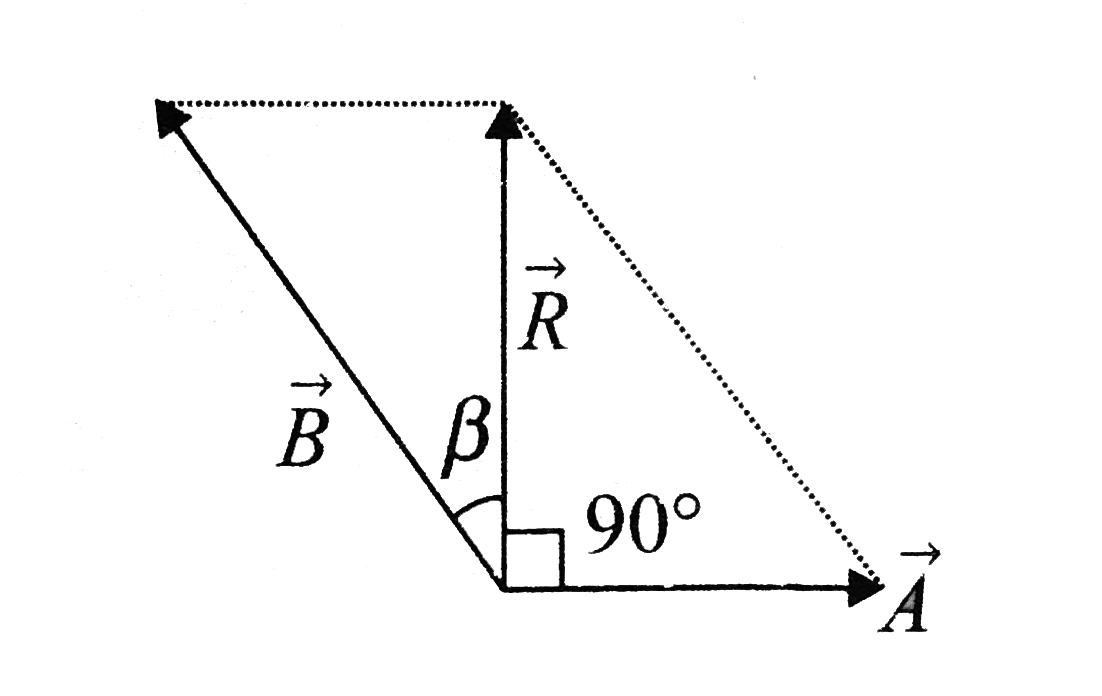The minimum value of the magnitude of →A+→B is ____.
To find the minimum value of the magnitude of the vector sum →A+→B, we can follow these steps:
Step 1: Understand the Vector Addition
The magnitude of the resultant vector →R=→A+→B can be expressed using the formula:
|→R|=√|→A|2+|→B|2+2|→A||→B|cosθ
where θ is the angle between the vectors →A and →B.
Step 2: Identify the Minimum Condition
To find the minimum value of |→R|, we need to consider the cosine term. The cosine function achieves its minimum value of -1 when θ=180∘. This means the vectors are in opposite directions.
Step 3: Substitute the Minimum Angle
Substituting θ=180∘ into the formula gives:
|→R|=√|→A|2+|→B|2+2|→A||→B|(−1)
This simplifies to:
|→R|=√|→A|2+|→B|2−2|→A||→B|
Step 4: Simplify the Expression
Using the identity a2+b2−2ab=(a−b)2, we can rewrite the expression:
|→R|=√(|→A|−|→B|)2
Thus, we have:
|→R|=||→A|−|→B||
Step 5: Conclusion
The minimum value of the magnitude of →A+→B is:
|→A|−|→B|
if |→A|≥|→B|, or |→B|−|→A| if |→B|≥|→A|. Therefore, the minimum value is:
Minimum value=||→A|−|→B||
The magnitude of the resultant vector →R=→A+→B can be expressed using the formula:
|→R|=√|→A|2+|→B|2+2|→A||→B|cosθ
where θ is the angle between the vectors →A and →B.
To find the minimum value of |→R|, we need to consider the cosine term. The cosine function achieves its minimum value of -1 when θ=180∘. This means the vectors are in opposite directions.
Substituting θ=180∘ into the formula gives:
|→R|=√|→A|2+|→B|2+2|→A||→B|(−1)
This simplifies to:
|→R|=√|→A|2+|→B|2−2|→A||→B|
Using the identity a2+b2−2ab=(a−b)2, we can rewrite the expression:
|→R|=√(|→A|−|→B|)2
Thus, we have:
|→R|=||→A|−|→B||
The minimum value of the magnitude of →A+→B is:
|→A|−|→B|
if |→A|≥|→B|, or |→B|−|→A| if |→B|≥|→A|. Therefore, the minimum value is:
Minimum value=||→A|−|→B||
Topper's Solved these Questions
Similar Questions
The resultant of two vectors →Aand→B perpendicular to the vector →Aanditsmagnitudequal→halfofthemagnitudeofthe→−−→r vec B.F∈doutthe∠between vec A and vec B.
View SolutionTwo vectors →Aand→B have equal magnitudes.If magnitude of (→A+→B) is equal to n times of the magnitude of (→A−→B) then the angle between →Aand→B is :-
View Solution
Knowledge Check
The maximum value of the magnitude of the resultant of two vectors →Pand→Q is 24 units and the minimum value of the magnitude of their resultant is 4 units. What is the ratio of the magnitudes of the vectors →Pand→Q ?
A34B45C65D75The resultant of two vectors →Aand→B is perpendicular to the vector →A and its magnitude is equal to half the magnitude of vector →B. What is the angle between →Aand→B ?
A30∘B45∘C150∘D120∘Two vectors →A and →B have equal magnitudes. If magnitude of →A−→B is equal to (n) times the magnitude of →A−→B, then angle between →A and →B is ?
Acos−1(n−1n−1)Bcos−1(n2−1n2+1)Ccos−1(n−1n−1)Dcos−1(n2−1n2+1)
Two vectors vec A and vec B have equal magnitudes.The magnitude of (vec A+vec B) is 'n' times the magnitude of (vec A-vec B).The angle between vec A and vec B is:
View SolutionGiven →A+→B+→+→D=0, can the magnitude of →A+→B+→C be equal to the magnitude of vec D Explain.
View SolutionTwo vectors →A and →B have precisely equal magnitudes. For the magnitude of →A+→B to be larger than the magnitude of →A−→B by a factor of n, what must be the angle between them?
View SolutionA vecto →A has magnitude 2 and another vector →B has magnitude 3. They are perpendicular to each other. By vector diagram, find the magnitude of →A+→B and dhow its direcction in the diagram.
View SolutionThe resultant of two vectors →A and →B is perpendicular to the vector →A and its magnitudes is equal to half of the magnitudes of vector →B (figure). The angle between →A and →B is

View Solution
